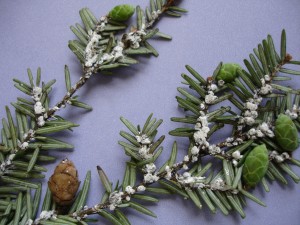You may be able to prevent or save tree and shrub hemlock(s) from woolly adelgid. This serious pest has two generations per year. The first generation hatches in March and April from overwintering adults (as many as 300 eggs per adult) in white cottony masses on the small twigs. The crawlers (nymphs) hatch and feed in April and May. The spring generation ends by mid- June. A second crawler generation emerges in July and feeds until mid- October.
Loss of a hemlock tree or shrub hedge does not over 1-2 years. It may take a buildup of 3-4 years before serious damage occurs. Inspect hemlock(s) several times of the year for white adelgid masses on the underside of twigs and needles.
Imidacloprid is the most popular insecticide of choice. It acts systemically. The pesticide must be watered into the soil within 24-36 hours, to carry it down the hemlock roots to be absorbed. Imidacloprid and other pesticides appear to be effective over two and more years.
Read and understand the pesticide label! Do not use around streams or ponds or in rocky soils. Pesticide rates will vary according to the size of the tree trunk or the height of the hedge. Most soil drenches contain imidacloprid, including Bayer Advance Garden Tree and Shrub Insect Control™, Merit 75 WP, Malice 75 WSP, Zenith 75 WSP. Safari 20 SG (dinotefuran) has slightly faster uptake by the tree. Safari may be used as soil drench or bark spray.
Most pesticides may be purchased from garden centers, home hardware, and farm supply stores.
Credit: Special thanks for information and photos supplied by NC State University and University of Tennessee Extension.


 Posted in
Posted in 
